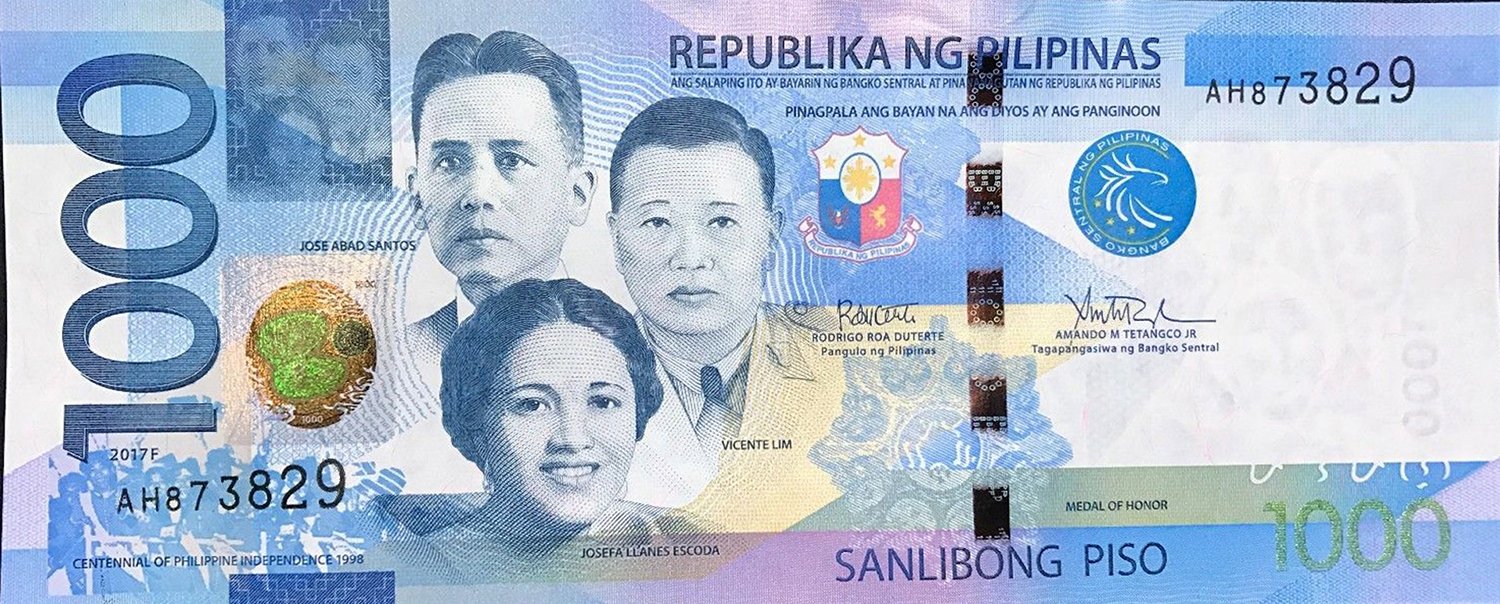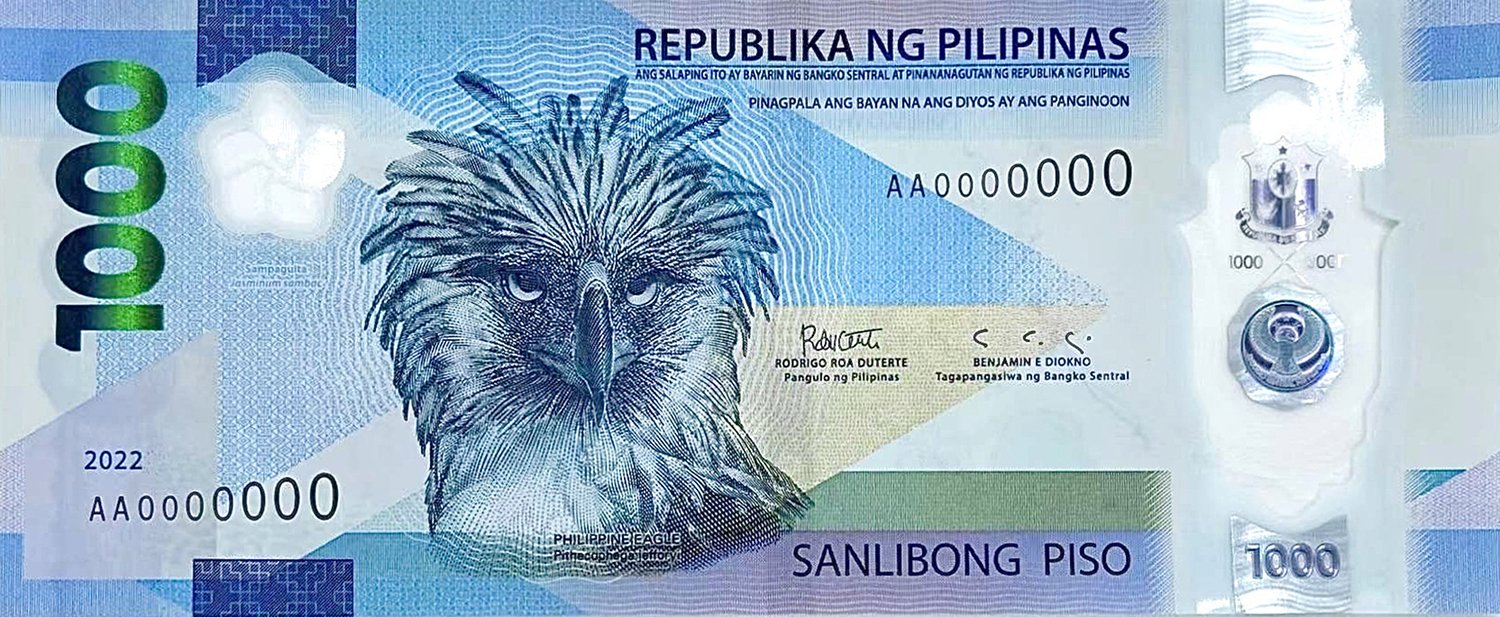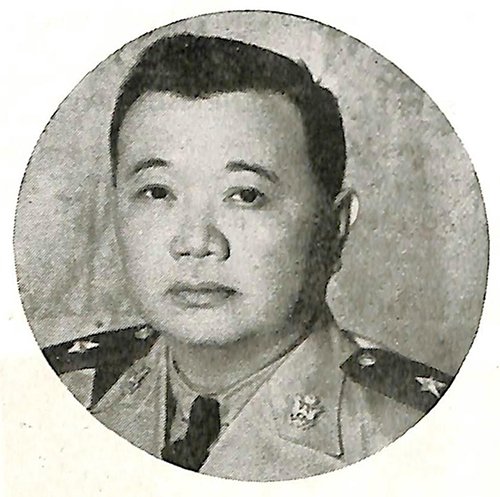Save Our Heroes from Historical Devaluation
/The P 1,000 bill with Jose Abad Santos (top left), Josefa Llanes Escoda (bottom) and Gen. Vicente Lim
It was a tribute not just to the three heroes, but also to the more than one million Filipinos who died during the Second World War -- a fitting tribute by a grateful nation. The bill's design was much lauded and welcomed by all, and has, over the years, provided a quick history lesson and inspiration for many Filipinos.
Last December 12, 2021, BSP announced that the images of the three heroes will be removed in lieu of the Philippine Eagle. BSP says it's time to revamp the heroes in favor of highlighting Philippine flora and fauna.
The new P 1,000 bill with the Philippine Eagle
Love of country, self-sacrifice, and valor are but a few of the values Filipinos are reminded of every time they see the three heroes on the P1,000 bill, something that the Philippine eagle, despite its majesty and splendor, cannot replace. Of all the country's paper bills, only the P1,000 bill has images of heroes; all else bear the images of politicians and presidents. So it's really sad to see the images go. Said BSP Governor Benjamin Diokno apathetically, "Heroes will remain heroes whether they are in the notes or not."
Diokno said that the new bill design was approved by the National Historical Commission of the Philippines (NHCP), a claim denied by the said agency, saying no consultation was made with them. NHCP Chairman Dr. Rene Escalante told the public to spare the agency as it has nothing to do with the redesign and to address all concerns and questions to the BSP. This "spare us" statement did not sit well with many citizens and historians as NHCP's very mandate was to be the vanguard of Philippine history and protector of Philippine legacies. Now is the time for NHCP to step up and protect our history. A mere denial of involvement is not enough. But as of this writing, a week into the controversy, the public has yet to receive a statement from the NHCP.
It was also announced that 500 million pieces of this new bill will be printed on polymer (plastic) material, the printing of which will be done in Australia. This initial batch will be to "test run" the material, if it is suitable for Philippine conditions. BSP has enumerated the merits of using polymer for durability and hygiene reasons, citing it can even be disinfected, but critics have expressed concern over the plight of abaca farmers, as abaca makes up 20% of the material of our current paper bill. Also, the huge quantity of paper bills to be printed for "test circulation" had critics baffled as this was not in agreement with BSP's push to digital banking, especially during this time of pandemic.
BSP received much flak from the public, and in a bid to appease the people, BSP Governor Diokno, in a press release, said that the paper hero bills would not be demonetized, and would continue to be printed alongside the polymer eagle bills. But Deputy Governor Mamerto Tamongan announced two days later that the hero bills would be circulated until stocks run out. Furthermore, while Diokno initially claimed that the new bill design was approved by the National Historical Commission (NHCP) of the Philippines, Tamongan said that they did not need to consult the NHCP as they consulted the Department of Environment and Natural Resources for the design of the eagle. These are conflicting statements from two of the highest officials of the BSP.
“Of all the country’s paper bills, only the P1,000 bill has images of heroes; all else bear the images of politicians and presidents. So it’s really sad to see the images go.”
It is ironic how the three heroes who sacrificed all and helped fight for our country's freedom are the ones needing saving now. It is very telling how this government treats its war heroes and martyrs.
An online petition was launched by the Philippine World War II Memorial Foundation on December 13 to appeal to the BSP not to remove the heroes from the bill, using the platform change.org. For those who want to save our heroes, let your voices be heard.
Please log on to change.org and sign the petition "No to the removal of our WW2 Heroes from our 1k Bill. Most importantly, share this petition to family and friends!
Des Benipayo is the VP for Research and Education of the Philippine World War II Memorial Foundation. Her book "HONOR: The Legacy of Jose Abad Santos" won Best Nonfiction Book in the 2019 National Book Awards, and its docu-film version of the same title was given the highest rating of "A" by the Philippine Cinema Evaluation Board.
Sidebar
The Last Time They Were Seen Alive
By Jose Victor Z. Torres
JOSE ABAD SANTOS was arrested along with his son, Jose Jr., while evading capture from the invading Japanese in the Visayas. The Japanese, knowing the high position their prisoner occupied in the Commonwealth Government, ordered him to collaborate with them. Abad Santos refused. On May 2, 1942, he was executed.
Jose Abad Santos being sworn-in as Chief Justice (Source: Wikipedia)
The last time Pepito saw his father was the moment he was being marched away to his execution. Pepito was shown his father's grave by some of his Japanese guards hours later, but when he returned to the site after the war, he could no longer locate it. Abad Santos' last resting place remains unknown.
GEN. VICENTE LIM was the Filipino commander of the USAFFE forces on Bataan when it surrendered. After his release from the prisoner-of-war camp in 1943, he continued to fight the Japanese through the underground movement. In 1944, he was captured off the coast of Batangas by the Japanese as he was making his way to Australia to help MacArthur in planning the invasion of the Philippines. Lim was brought to Fort Santiago where he underwent severe torture. Survivors of the fort's dungeons remember Lim keeping them in high spirits in spite of his pain and suffering. He was sentenced to death and was last seen being brought out of the fort to the Old Bilibid Prison after which he disappeared.
Brig. General Vicente Lim
It was only 50 years later, that Lim's family and relatives learned that he was executed at the Chinese Cemetery along with other suspected guerillas. His last resting place remains unknown.
JOSEFA LLANES ESCODA was the other half of a husband-and-wife underground team who helped the POWs in the Japanese camps and conducted underground work in the guerilla movement. In 1944, Antonio Escoda was arrested by the Japanese, and Josefa knew it was only a matter of time before she was to face the same fate.
Josefa Llanes Escoda (bottom row, third from left) helped form the Girl Scouts of the Philippines.
On that day, 27 August 1944, when the Japanese came, her daughter 16-year-old Maria Teresa Escoda Roxas was in the same room with her mother. Before Josefa was taken away, she told Teresa to play the piano "and not to stop playing and not to turn around no matter what." As she played the piano, Josefa was led away. The only sound Teresa heard of what was to be the beginning of the end of her mother's life was the door of their house slamming behind her. She never saw her again.
There is another eyewitness account of the last days of Josefa Llanes Escoda, and this was told by the late Philippine Star editor, Max Soliven. As he was biking along España Boulevard, Soliven saw a row of Japanese military trucks roaring by. The rear canvas flap of one of the trucks flew open and to his surprise, he saw Josefa Llanes Escoda sitting with a group of Filipino prisoners (one of them was the writer Manuel Arguilla who was easily recognizable by the huge birthmark on his face).
Soliven said that he biked after the trucks and tailed them closely until Escoda looked up and saw him. She frantically waved him away, not to follow them, for he might get shot by the Japanese. But Soliven tailed them until he saw the trucks enter the old Bilibid Prisons. It was to be the last time he saw Escoda. It was said that several months later, she and her husband were executed. Their bodies were never found and their burial places remain unknown to this day. REMEMBER.
Reposted with permission from the author’s Facebook page.
Jose Victor Z. Torres is a History professor at De La Salle University-Manila









